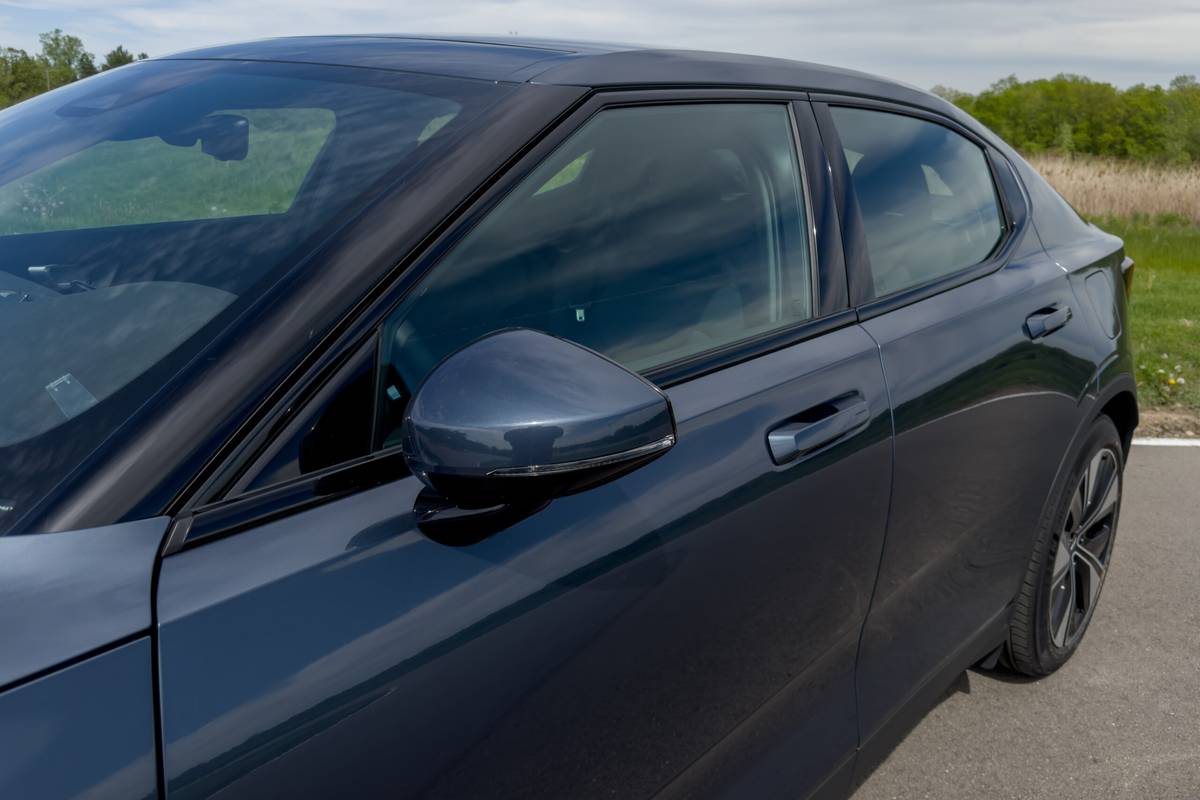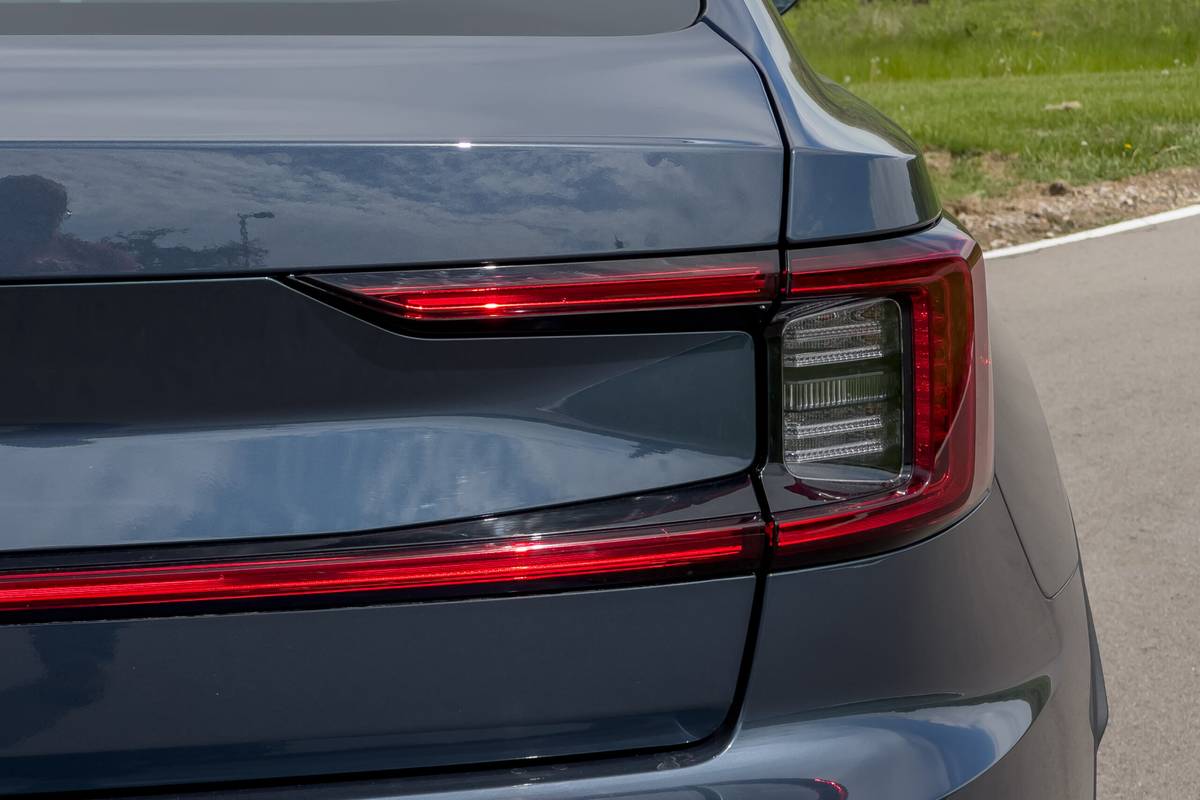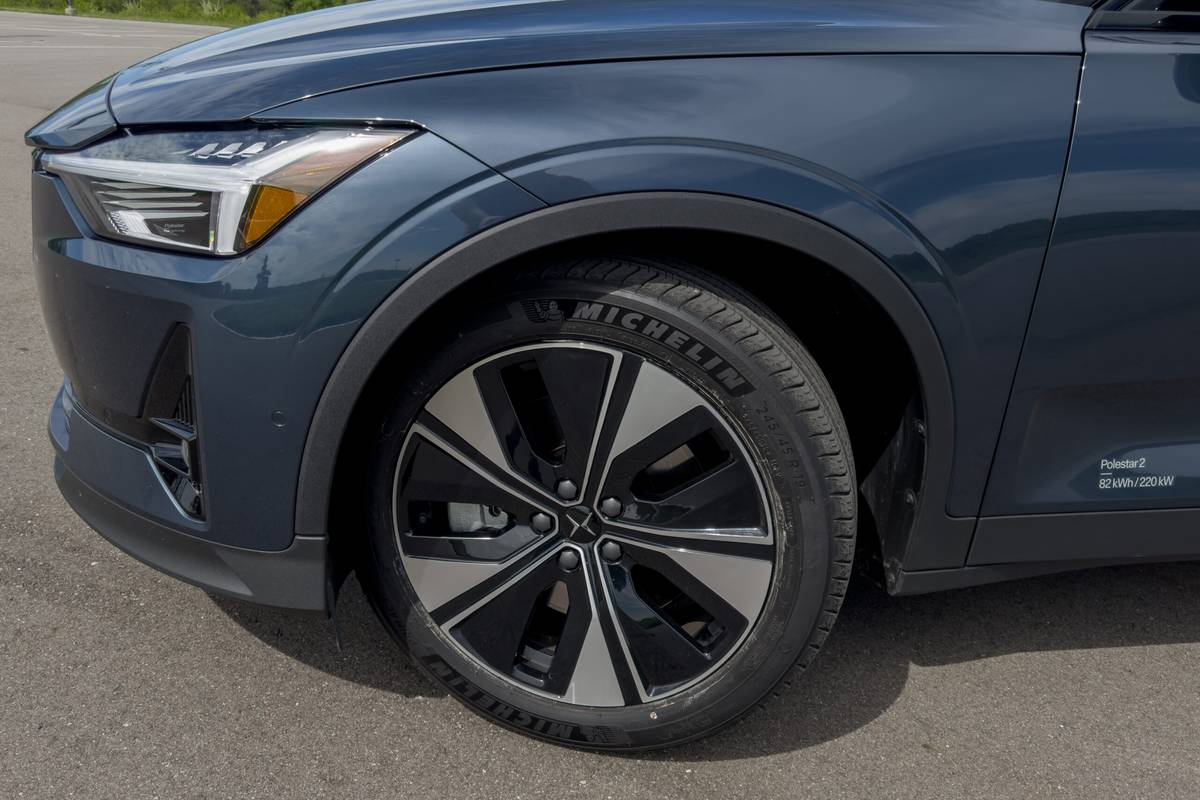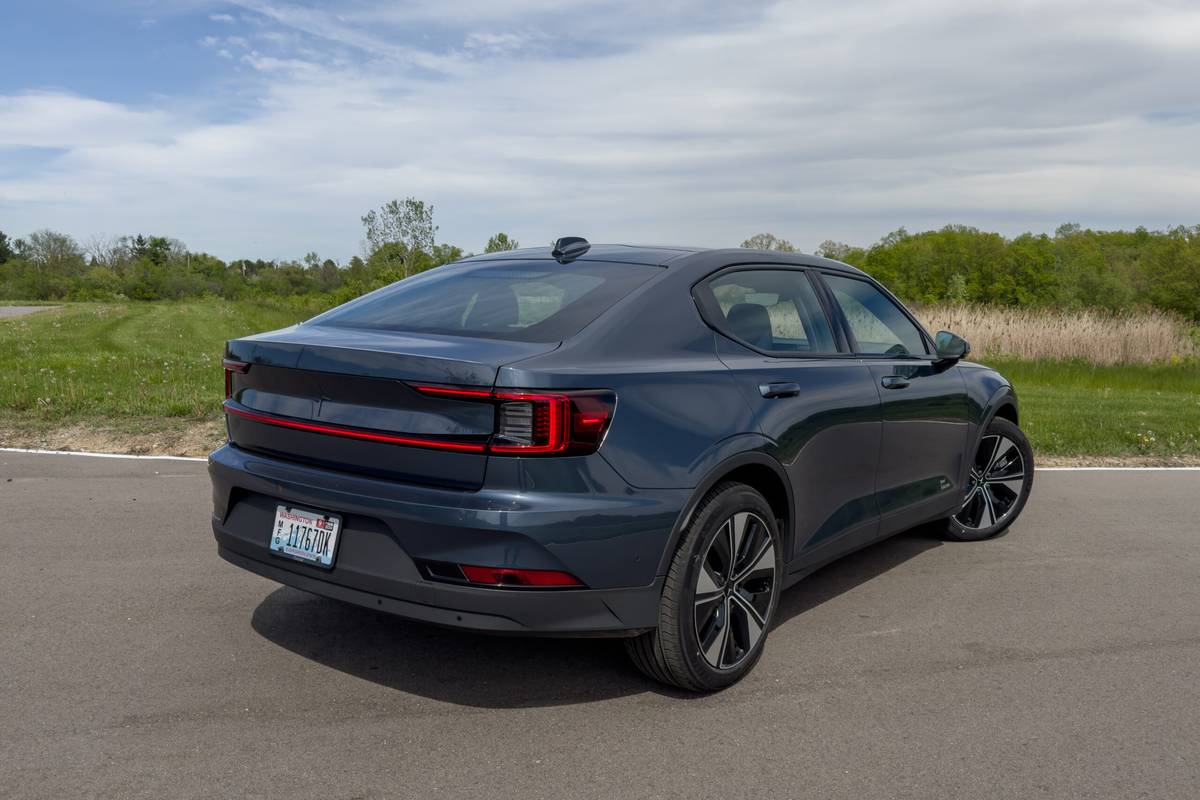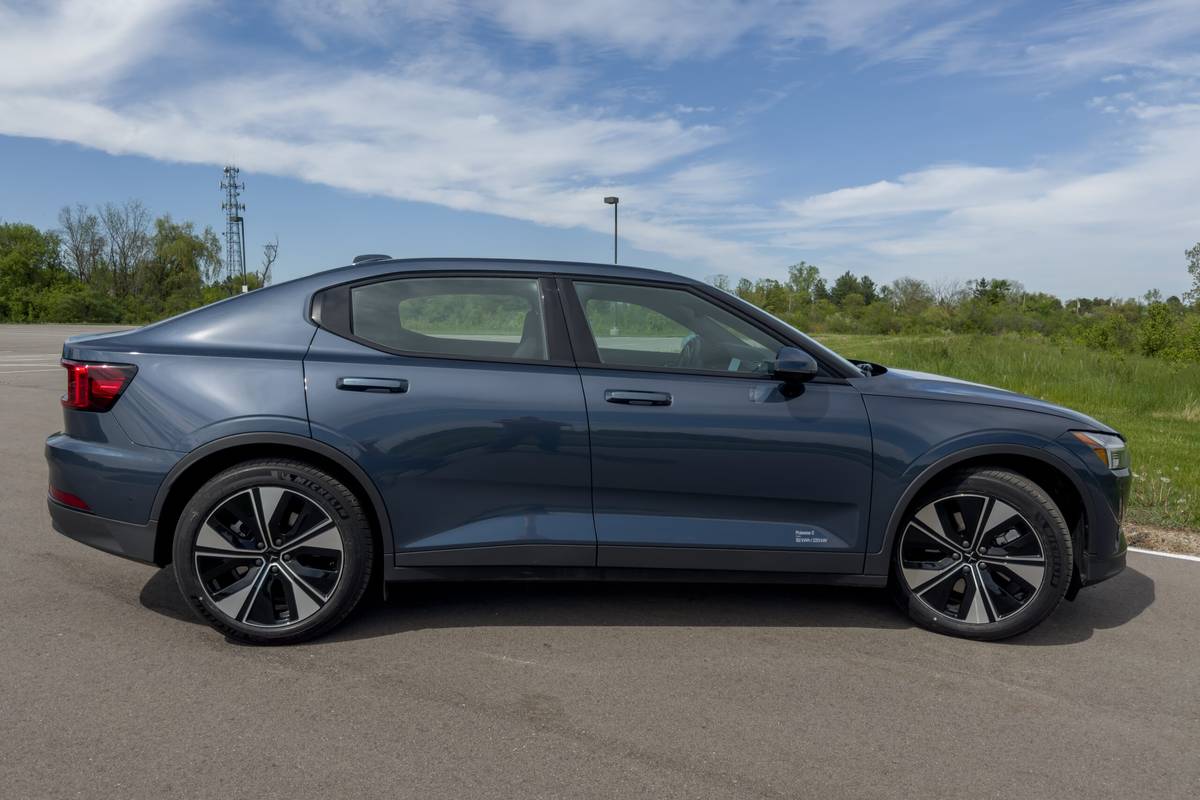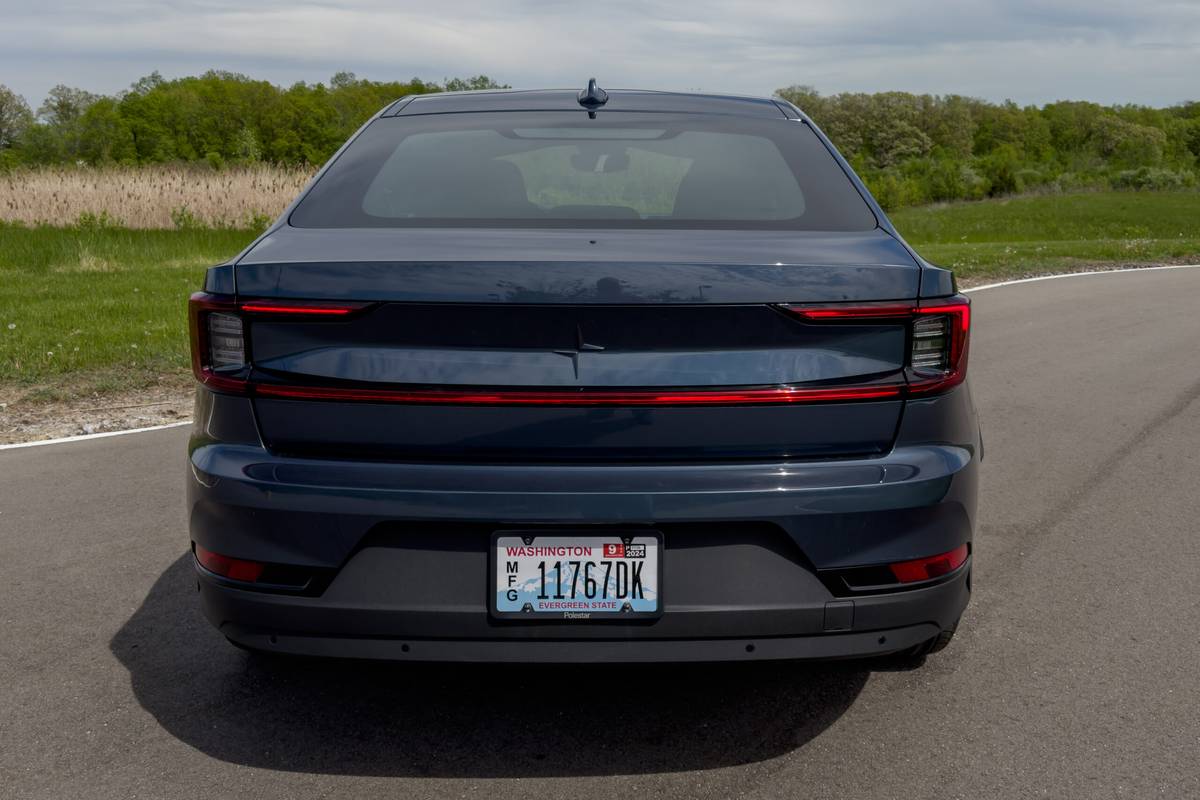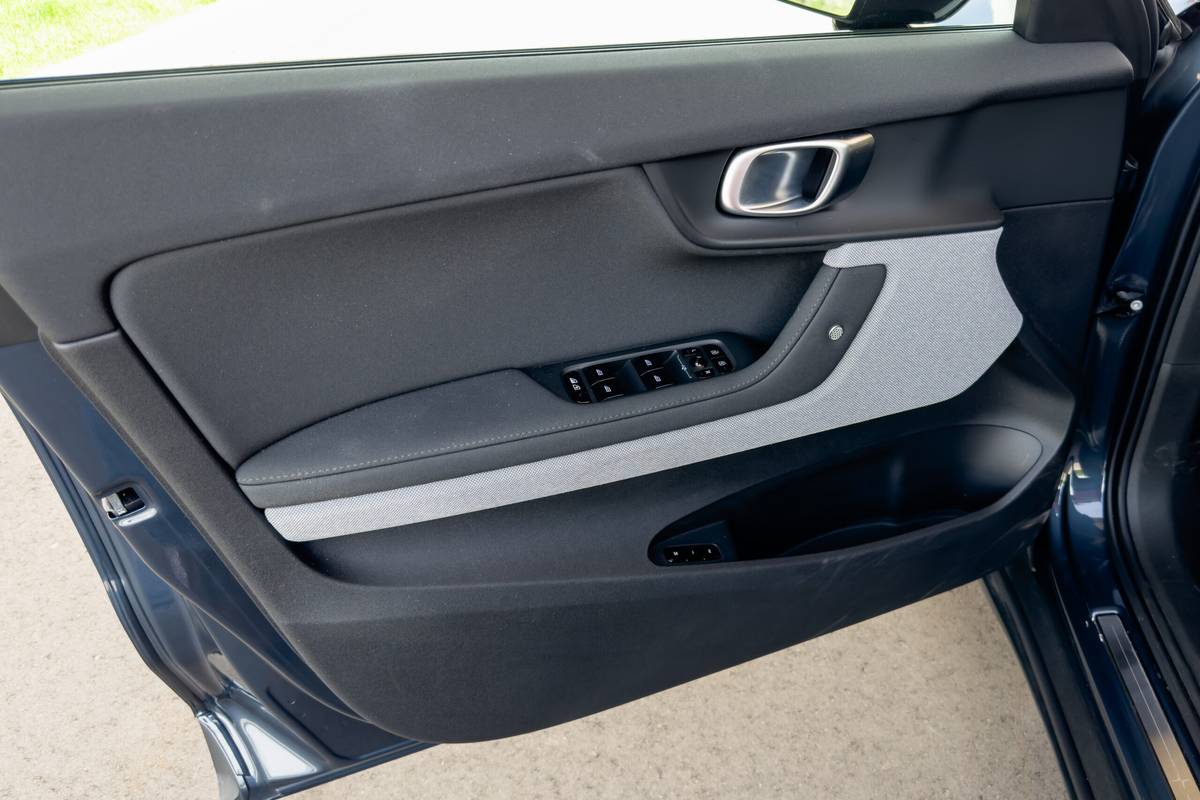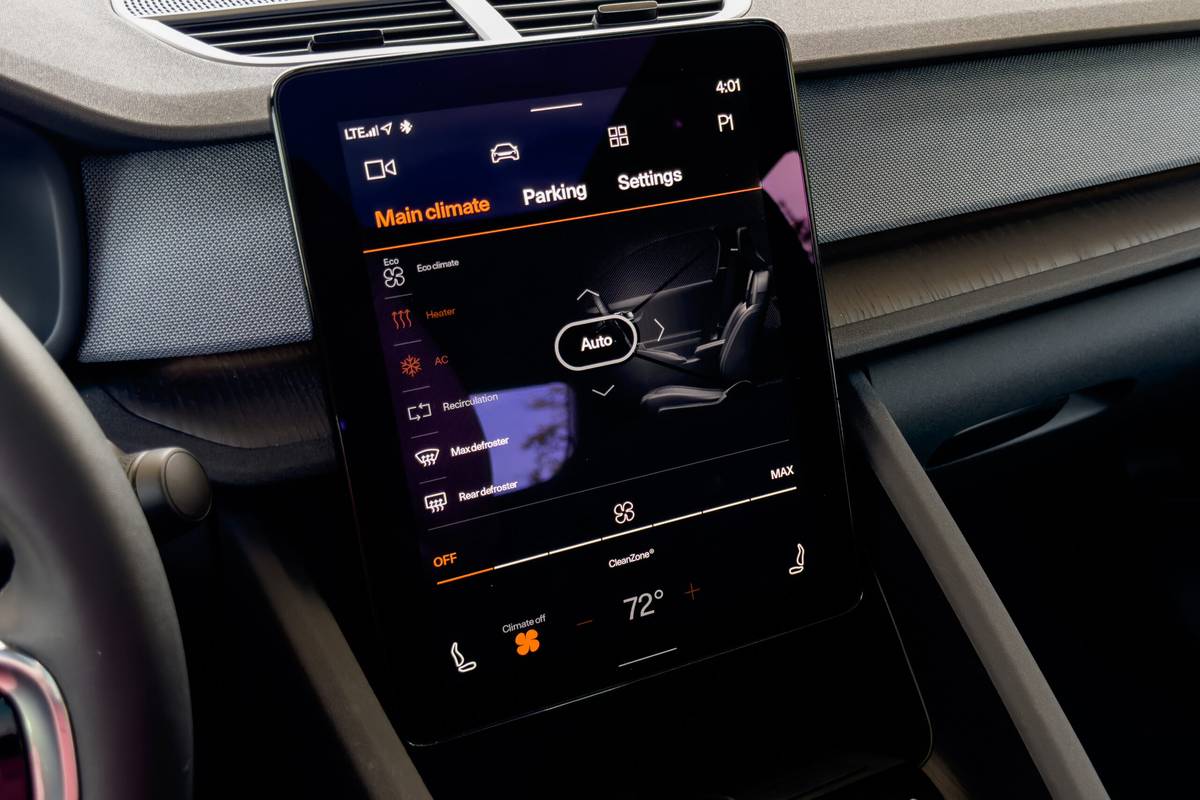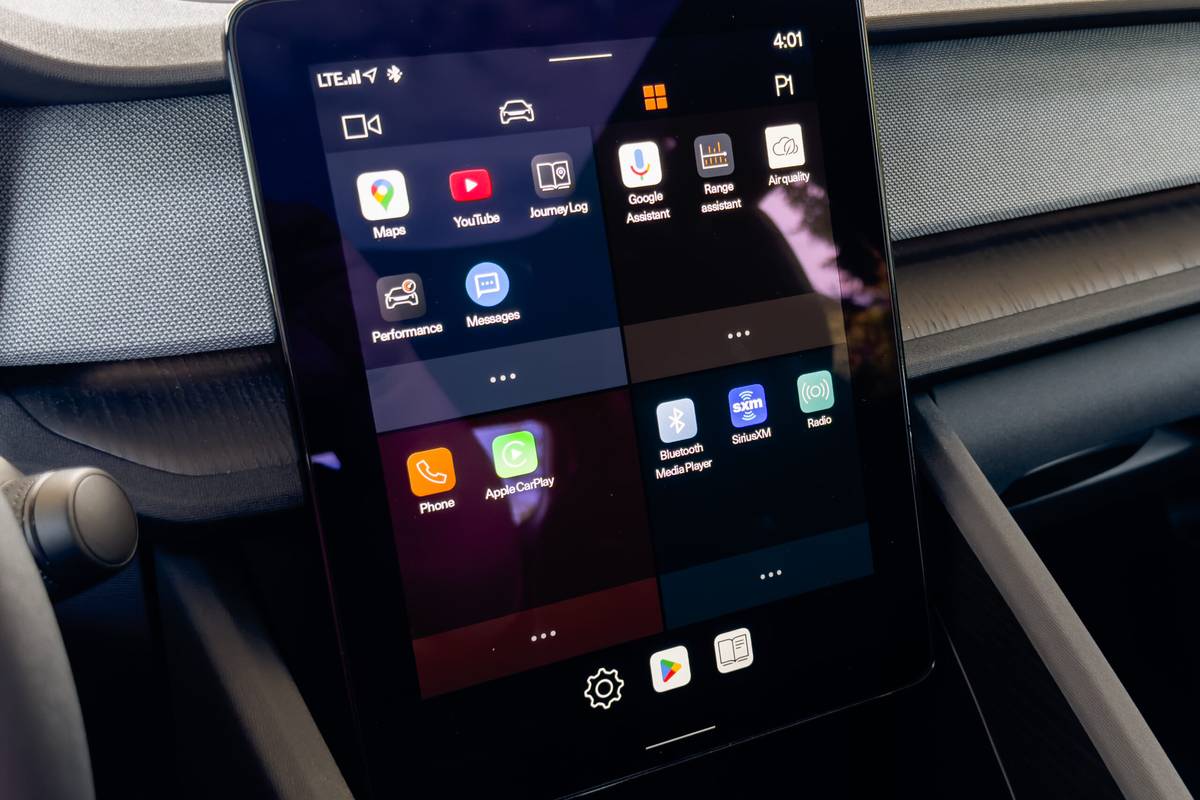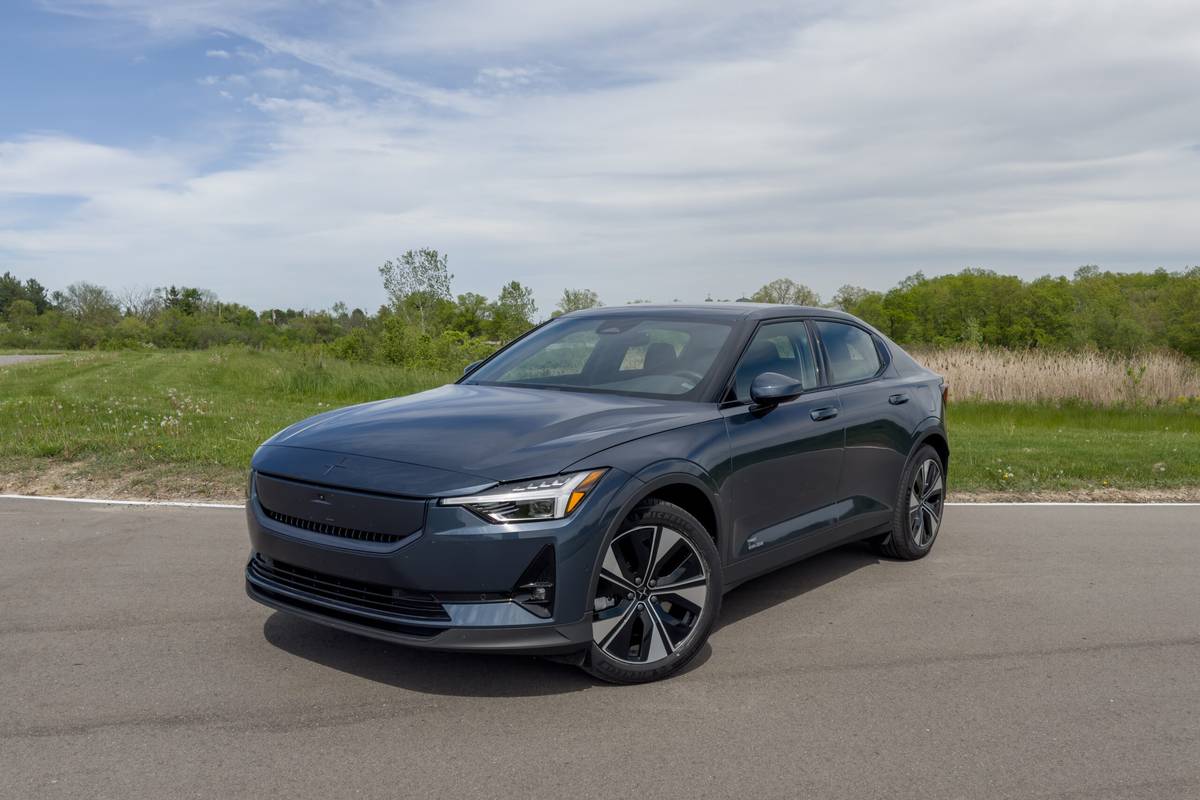
The verdict: Sportier than the prior model year thanks to a change in driven wheels, the rear-wheel-drive 2024 Polestar 2 is more engaging to drive, but it still falls short in terms of user-friendliness and onboard technology.
Versus the competition: The Polestar 2 RWD is not as quick as many competitors, and it’s not as engaging to drive as a Tesla Model 3 Performance, BMW i4 or even a Hyundai Ioniq 6. It’s comfortable and useful as a hatchback, but its interior feels less luxurious than those of its rivals.
Just looking at the Polestar 2 pictured here, it’s hard to tell it apart from the one that debuted from the Chinese-controlled (Volvo-affiliated, ostensibly Swedish) electric luxury brand. It certainly looks the same; there aren’t even any new or interesting colors to be had on the 2024 version of Polestar’s entry-level four-door hatchback EV. But the pictures don’t show a massive change made for the new year: Polestar switched up the base 2’s standard single-motor setup, moving that motor from the front wheels to the back wheels.
Related: 2024 Polestar 2 Adds More Power, Gets Up to 300 Miles of Range
That’s the beauty of electric-car platforms: Most of them are essentially a kind of “skateboard” — with motors at each end and batteries in the middle — on top of which rides a “top hat” structure (the car body). So what Polestar has done is fairly simple, but the result is a big change in the dynamic of the 2’s lineup of single- and dual-motor models: It now includes a rear-wheel-drive vehicle and a rear-biased all-wheel-drive variant, ostensibly making it more attractive to an enthusiast crowd. We got one for a week to see if the switch makes any real difference in daily use.
All the Things You Cannot See
Forget the way the ‘24 Polestar 2 looks; all that’s changed is a new front-end panel between the headlights to accommodate some new sensors. Polestar didn’t give it any major style updates for the model year, and there are only a couple of color changes for the ‘25 model year (but they’re all still boring, muted “urban-inspired” hues). The Polestar 2 is still a four-door, five-seat hatchback with a fixed glass roof, and it’s still a stylish Scandinavian take on an electric compact car.
We certainly don’t hate that it’s a hatchback, as the utility gained from this body style is undeniable; most duties don’t require an SUV when you have this level of cargo space utility. The 2’s design doesn’t stand out in any way, allowing it to fly under the radar most of the time — especially in the dark Midnight Metallic color my test vehicle was painted. If you’re looking to go unnoticed by civilians and constabulary alike, a muted-hue Polestar 2 is, frankly, a good way to go about it.
The big changes for the 2024 Polestar 2 are all under the skin, and they come in two areas. First is the aforementioned switch from FWD to RWD for the base single-motor model. Power, battery capacity and range are all up, too. My test vehicle was a single-motor RWD Plus trim level with 299 horsepower and 361 pounds-feet of torque — both healthy bumps over the ‘23 model’s 231 hp and 243 pounds-feet. Polestar says the increase in power has made a significant improvement in acceleration, knocking 1.1 seconds off the car’s 0-60 mph time, which now sits at a Polestar-reported 5.9 seconds. The single-motor ‘24 Polestar 2 uses a larger 82-kilowatt-hour battery (79 kWh usable) that contributes to improved range over the ‘23 model; this version’s range tops out at 320 miles, according to the EPA. The company says this version will go from a 10%-80% charge on a DC fast charger in about 28 minutes at up to 205 kilowatts (if the stars, temperatures and conditions align, of course). So, how do the changes made to the 2024 Polestar 2 add up? Does it feel any different?
Out on the Street
For most people driving a Polestar 2 every day — commuting on highways, byways, two-lanes and boulevards — the answer is no. You won’t notice the switch from FWD to RWD. The change really only shows up when you drive aggressively, as you might on a twisty back road or when canyon-carving down your favorite mountain pass. The old Polestar 2 would understeer at its limits even with AWD, but this new one is much more tail-happy, allowing you to adjust the car’s trajectory in corners using the accelerator pedal. But the Polestar 2 isn’t really built for that kind of driving; there’s no Sport mode, just adjustable steering effort. You’ll notice the rear-drive feel when executing turns from a stop, such as when pulling out onto a road and accelerating hard, but the traction and stability control systems intervene quickly, before the rear tires can break loose. Overall, the feel of the rear-drive car is more sporty and engaging, but, again, only when driven aggressively. You might notice the RWD layout in slippery conditions or snow, but if you live somewhere with inclement weather, all-season or winter tires will make much more of a difference than front- versus rear-wheel drive.
The rest of the Polestar 2 behaves much as before. The ride and handling balance is excellently tuned, with a compliant, bump-absorbing suspension that avoids the wallowy nature that’s often associated with heavy electric sedans. Handling is reasonably sharp, but if you’re really looking for a sporting experience, an available Performance Pack that can be added to the dual-motor AWD version is really the way to go. The 2’s adjustable-effort steering can go from video-game numb to decently involving, but it’s not particularly communicative or sporting. The brakes are strong and provide decent feedback, and a more aggressive one-pedal driving mode is available for increased regenerative braking if you’d rather have a full-on EV experience.
In a nutshell, the added power and switch to a rear-drive setup has helped make the Polestar 2 more appealing to enthusiasts, but it hasn’t transformed the base model into a true sporty EV. Throwing down with a BMW i4 would show that in stark detail, as the BMW is much sharper in its responses. A Hyundai Ioniq 6 sedan is also just as entertaining to drive as the Polestar, while a Tesla Model 3 Performance is a considerably sharper tool.
Cabin and Tech Woes
The bit that hasn’t changed for the better is the 2’s cabin and technology. It’s reasonably comfortable up front in the Polestar 2 — though the backseat is a little cramped for headroom and legroom — and the shapes and designs inside are just as Scandi as the outside. It’s a clean, simple look that’s nicer than most of what Tesla offers, but it falls short in a number of areas. The designs might be attractive, but the colors and materials are dour and depressing; there’s no color in any of the Polestar lineup, it seems, inside or out. Everything is grayscale, with a few dark blues thrown in and an occasional gold highlight on things like the brake calipers and seat belts in vehicles with performance options. The rest of the interior is just dark, rubbery, neoprene-feeling materials. The rubberized recycled materials on the dash and seats give the interior the distinct smell of a wetsuit, which isn’t terribly inviting. The Ioniq 6 has an equally modern interior with equally appealing shapes, but surprisingly superior materials. The BMW i4’s interior quality and materials choices are vastly superior.
Things haven’t improved with the Polestar 2’s Android Automotive operating system, either, which powers the multimedia and gauge displays. It uses Google Built-In, so if you’re well entrenched in the Googleverse with all of your personal data and communications applications via mobile phone and other outlets, all you’ll need to do is add the Polestar 2 to your pantheon of Google devices. For Apple users, it’s more of a burden to integrate, though CarPlay connectivity is included. But regardless of how much you want to bring the Polestar 2 into your life’s data infrastructure, its multimedia system just isn’t great. It’s a bit confusingly organized, almost all controls are in the touchscreen (including the climate controls, which we detest), and it doesn’t offer much in the way of customization or reconfigurability.
For being a digital screen, the gauge cluster itself is remarkably spartan — no audio information is available in the cluster, and it can only switch back and forth between the gauges or a full-width navigation screen. You can’t customize it at all, which smacks of cheapness; isn’t one big point of a digital display the ability to make it suit your needs? Again, Hyundai and BMW are worlds ahead in this department, offering far more interesting displays with myriad options and tons of selectable information.
More From Cars.com:
- 2025 Polestar 2 Gets Longer Range, More Options
- 2025 Polestar 3 Adds Rear-Drive, Single-Motor Base Variant
- 2025 Polestar 4 Up Close: New ‘SUV Coupe’ Looks (Only) Ahead
- 4, 5, 6: 2025 Polestar 4 Electric SUV Pricing Released, Starts at $56,300
- Shop for a 2024 Polestar 2
Not Getting What You Pay For?
One of my original complaints about the Polestar 2 was that it simply didn’t feel as sophisticated, luxurious or technologically advanced as its price seems to necessitate. Despite getting a boost to its performance chops and driving engagement, that remains the 2024 Polestar 2’s dominant fault. With a starting price of $51,300 (all prices include destination fee), the Polestar 2 should be far and away more luxurious, opulent and advanced than a $38,650 Hyundai Ioniq 6 SE Standard Range, but it’s not. In fact, a fully loaded AWD Ioniq 6 Limited, which will run you $55,800, is a far better deal than that basic Polestar 2 Long Range Single Motor RWD for $51K. The BMW i4 Gran Coupe has similar specs to the Polestar but again features a much more appealing interior for similar money. Of course, the EV to beat in this segment is still the Tesla Model 3, which is much cheaper in RWD form, starting at $40,380. It’s fairly even money with a Polestar 2 in the Model 3’s Performance AWD trim, but the Tesla blows the 2 away in terms of performance. We’re talking a 2.9-second 0-60 time for around $56,000; that money gets you a 0-60 mph time of roughly four seconds in an AWD Polestar 2 — and that’s before you consider the $7,500 federal tax credit that the Tesla qualifies for. The Polestar 2 is only eligible for that credit on leases.
That really is the Polestar 2’s ultimate problem: It’s not a style standout, it’s not a performance standout, and it doesn’t do EV things in a particularly unique way or better than anyone else. It doesn’t offer the kinds of features and customization you can get elsewhere for less money, and it’s not a particularly good value. That makes it hard to recommend the Polestar 2 in the still-nascent luxury electric car class.
Related Video:
We cannot generate a video preview.
Cars.com’s Editorial department is your source for automotive news and reviews. In line with Cars.com’s long-standing ethics policy, editors and reviewers don’t accept gifts or free trips from automakers. The Editorial department is independent of Cars.com’s advertising, sales and sponsored content departments.
















